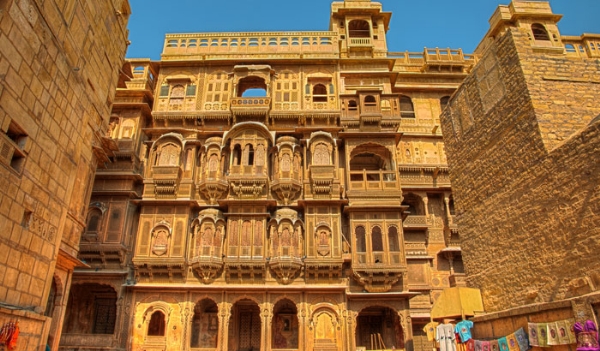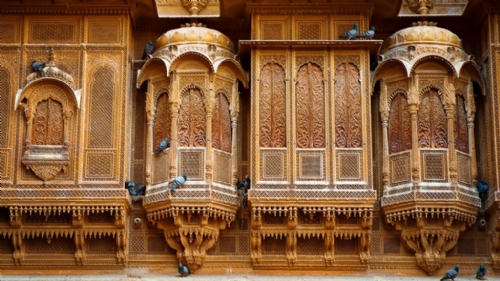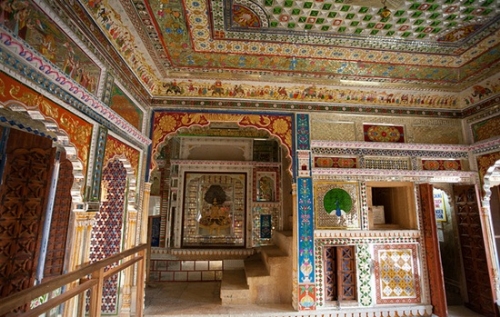Patwon ki Haveli: the 19th century grandeur of Jaisalmer!
Patwon Ki Haveli was built in the early 1800s by Guman Chand Patwa, who was an affluent merchant from Jaisalmer
Total Views |
Who says one can only experience grandeur and regale in palaces or castles where the royalty once resided? Let us take a glimpse at a small nook in time and history, where one can find grandeur in the most unexpected places, like the one we will explore today. Also known as Mansion of Brocade Merchants, the Patwon Ki Haveli is a popular tourist attraction in Jaisalmer, Rajasthan. At first glance at it, we can see several windows and balconies having detailed carvings.

Guman Chand Patwa wanted to build a haveli in Jaisalmer and commissioned its construction in 1805. As time progressed and as he made more profits in trading, he decided to create five separate havelis for his sons in the same complex. Patwon Ki Haveli took about 60 years to be constructed entirely and became the largest mansion in Jaisalmer.



On the inside, one can witness the grandeur of this Haveli. It is actually a cluster of 5 small havelis built by a rich trader in 19th Century. Locals also call this haveli Kothari’s Patwa Haveli. The 5 havelis were built for the family & the entire complex forms the largest mansion in Jaisalmer! The Haveli still has a huge number of artefacts and stonework which shows the regal lifestyle of Patwa family. The building is under the Archaeological Survey of India, and it is recognized as an architectural as well as a historical site.
Patwon ki Haveli is an interesting piece of Architecture and is the most important among the havelis in Jaisalmer. This is precisely because of 2 things, 1st that it was the first haveli erected in Jaisalmer & 2nd, that it is not a single haveli but a cluster of 5 small havelis. pic.twitter.com/UW4xRotGn7
— Clio's Chronicles (@CliosChronicles) May 31, 2021
The architectural grandeur poured into the haveli is evident through its exquisite wall paintings, balconies that give a panoramic view, gateways, arches. But the most important feature here is the mirror works on the wall. The murals in one of the sections of the Haveli are designed uniquely. Each portion separates from one another depicting a distinct style. Having over 60 balconies, the pillars and ceilings of the architecture are carved in the intricate designs and miniature works.
Also Read | Guru Ramrai Temple: the most important 17th century Gurudwara of Dehradun
History | Patwon Ki Haveli was built in the early 1800s by Guman Chand Patwa, who was an affluent merchant from Jaisalmer. Their family is said to be one of the famous dealers of gold and silver embroidery threads. They were thus recognised as the Brocade Merchants, and the haveli was also called the Mansion of Brocade Merchants. Rumours say that the family was also involved in smuggling opium illegally at that time.
Guman Chand Patwa wanted to build a haveli in Jaisalmer and commissioned its construction in 1805. As time progressed and as he made more profits in trading, he decided to create five separate havelis for his sons in the same complex. Patwon Ki Haveli took about 60 years to be constructed entirely and became the largest mansion in Jaisalmer.

Architecture | The Haveli is actually a 5-storey Rajputana mansion with traditional Jaisalmer architecture. It is made of yellow sandstone and has intricate detailing. Each floor forms a different haveli. The mansion on the ground floor (the first haveli) being the largest of them all. The Haveli is divided into 6 apartments.

The entire complex of havelis is beautifully decorated with several patterns carved into the sandstone. The gateways and arches are huge & intricately decorated. The interiors are fascinating with high ceilings, pillars, door frames, mirror work, paintings. There are 60 traditional Jharokhas / balconies and windows in the mansion, and each has ornately carved stone frames and latticework that brightens the place with natural light and helps cross ventilation.
Also Read | Shiva temple, Ambernath: The 1000-year-old gem in Mumbai!
Museum | Tourists can also visit the in-house museum here which Archaeological Survey in India maintains. The collection has artefacts from the 19th Century from this haveli. The museum also has other artefacts that give a glimpse into the culture, customs of Jaisalmer. Gateways, arches, balconies etc. have some rich mirror work from that bygone era which can be seen by tourists. The third Haveli too, hosts rare items including the traditional art & craft work of the locals there. Photography is allowed inside Patwon Ki Haveli, but tourists have to pay a small fee to carry their video or still cameras inside it.


